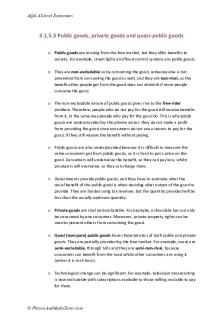Ostrom 2009 - Summary Paper on common goods PDF

| Title | Ostrom 2009 - Summary Paper on common goods |
|---|---|
| Author | Stefan Hanuska |
| Course | Politics, Philosophy and Economics |
| Institution | University of Oxford |
| Pages | 2 |
| File Size | 238.3 KB |
| File Type | |
| Total Downloads | 20 |
| Total Views | 126 |
Summary
Summary Paper on common goods...
Description
Elinor Ostrom (2009) – A General Framework for Analyzing Sustainability of Social-Ecological Systems (SES) Research Question: - General Consensus until recently has been that resource user will never self-organize to maintain their resource and governments must impose solutions (tragedy of commons) - What influences the likelihood of self-organization in efforts to achieve a sustainable social-ecological system? Or in other words when will the users of a resource invest time and energy to avert a tragedy of the commons? Theoretical Framework (4 first-level core subsystems and 10 second-level variables) - Subsystems: o Resource systems (e.g. a designated protected park encompassing a specified territory containing forested areas, wildlife, and water systems) o Resource units (e.g., trees, shrubs, and plants contained in the park, types of wildlife, and amount and flow of water) o Governance systems (e.g., the government and other organizations that manage the park, the specific rules related to the use of the park, and how these rules are made); o Users (e.g., individuals who use the park in diverse ways for sustenance, recreation, or commercial purposes) - Variables: Resource Systems: o Size of resource system (Small: not enough benefits, large: high monitoring costs => Moderate territorial size is most conducive to self-organisation) o Productivity of System (Abundant: no need to manage, exhausted: too late => Users need to observe some scarcity to self-organise) o Predictability of dynamic system (=> Needs to be sufficiently predictable; maybe chance to organize at higher level if it is unpredictable at small scale) Resource Units: o Resource unit mobility (=> Self-organisation more likely with stationary units such as trees than mobile resources such as unregulated waters) Users: o Number of users (large groups: high costs of assembling and agreeing, however, able to contribute more resources than smaller groups => relevant, but dependent on other variables and type of management tasks involved) o Leadership (=> if respected local leaders are among user, self-organisation is more likely) o Norms/social capital (=> if users share moral and ethical standards they are more likely to trust each other) o Knowledge of SES (=> if users share common knowledge of relevant SES attributes and how their actions affect each other, organizing costs are lower) o Importance of resource to users (=> if users are dependent on resource system regarding their livelihood or attach high value to the sustainability of resource) Governance Systems: o Collective-choice rules (if user groups have autonomy at the collective-choice level to craft and enforce their own rules they are likely to self-organise) Final remarks - Variables interact in non-linear way - If the initial set of rules established by the users, or by a government, are not congruent with local conditions, long-term sustainability may not be achieved - Simple blueprint policies do not work but framework variables have to be considered...
Similar Free PDFs

Public Goods and Common Resources
- 18 Pages

Handling stolen goods summary
- 3 Pages

Plant Propagation - Summary 2009
- 4 Pages

2009 16 Revision Paper(2021)
- 8 Pages

Sale of goods on CIF Terms
- 12 Pages

Research Paper on Filipino
- 13 Pages

Research paper on \"Fences\"
- 4 Pages

Quiz on Movie Tidal Wave 2009 1
- 8 Pages

Position paper on Crypto
- 2 Pages
Popular Institutions
- Tinajero National High School - Annex
- Politeknik Caltex Riau
- Yokohama City University
- SGT University
- University of Al-Qadisiyah
- Divine Word College of Vigan
- Techniek College Rotterdam
- Universidade de Santiago
- Universiti Teknologi MARA Cawangan Johor Kampus Pasir Gudang
- Poltekkes Kemenkes Yogyakarta
- Baguio City National High School
- Colegio san marcos
- preparatoria uno
- Centro de Bachillerato Tecnológico Industrial y de Servicios No. 107
- Dalian Maritime University
- Quang Trung Secondary School
- Colegio Tecnológico en Informática
- Corporación Regional de Educación Superior
- Grupo CEDVA
- Dar Al Uloom University
- Centro de Estudios Preuniversitarios de la Universidad Nacional de Ingeniería
- 上智大学
- Aakash International School, Nuna Majara
- San Felipe Neri Catholic School
- Kang Chiao International School - New Taipei City
- Misamis Occidental National High School
- Institución Educativa Escuela Normal Juan Ladrilleros
- Kolehiyo ng Pantukan
- Batanes State College
- Instituto Continental
- Sekolah Menengah Kejuruan Kesehatan Kaltara (Tarakan)
- Colegio de La Inmaculada Concepcion - Cebu






